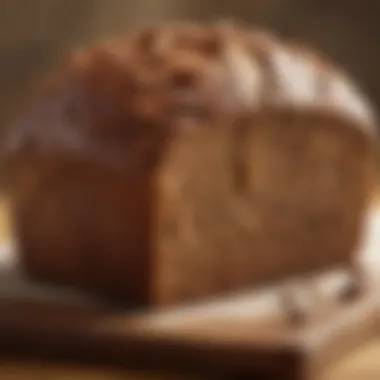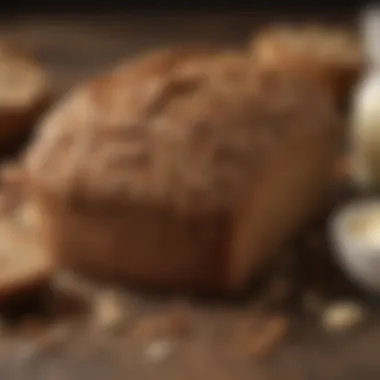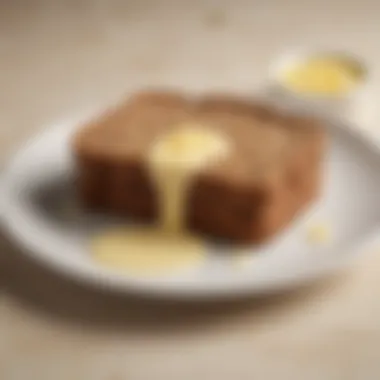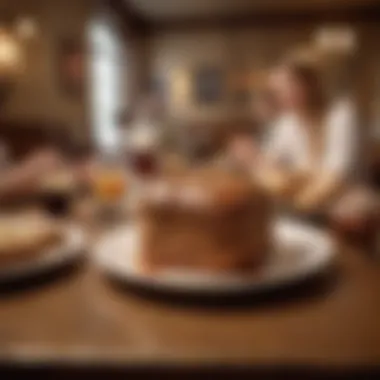Discovering the Richness of Brown Bread at The Cheesecake Factory


Intro
Brown bread at The Cheesecake Factory stands out not just for its unique flavor, but also for its roots in culinary trends that appeal to modern palates. The bread's texture and taste captivate many patrons, making it a beloved item on the menu. By examining this dish closely, we can uncover the details behind its ingredients, nutritional value, and popularity among diners. This article aims to shed light on all aspects of the brown bread, enriching our understanding of its appeal in today’s dining landscape.
Recipe Overview
Crafted to perfection, The Cheesecake Factory’s brown bread is more than just a side to enjoy with your meal. Known as Warm Brown Bread, this dish invites diners with its appealing texture and slightly sweet flavor.
- Portion Yield: Approximately 6 servings
- Prep Time: 15 minutes
- Cook Time: 30 minutes
- Difficulty Level: Easy
Main Ingredients
- Warm Whole Wheat Flour
- Honey or Sugar
- Cocoa Powder
- Yeast
- Butter
- Salt
Step-by-Step Instructions
Creating a version of The Cheesecake Factory’s brown bread involves several simple steps. Follow this method to recreate the experience at home:
- Prep Ingredients: Measure out all ingredients in advance. You will need whole wheat flour, cocoa powder, yeast, and honey for sweetness.
- Mix Dry Ingredients: In a large bowl, combine the flour, cocoa powder, yeast, and salt.
- Combine Wet Ingredients: In a separate bowl, mix melted butter and honey gradually into warm water.
- Incorporate Mixtures: Slowly add the wet ingredients to the dry mix, stirring until a dough forms.
- Knead: On a floured surface, knead the dough gently for about 10 minutes, or until it’s elastic.
- First Proving: Allow the dough to rise in a warm spot for about an hour, until light and doubled in size.
- Shape and Bake: Preheat the oven, shape the dough, place it on a baking sheet, and bake it for 25-30 minutes.
- Cool and Serve: Let it cool briefly before serving warm.
By following these clear steps, you can achieve a satisfying result similar to what The Cheesecake Factory offers.
Time-Saving Strategies
Consider using a stand mixer with a dough hook to knead the bread if your time is limited. Substituting whole wheat flour with all-purpose flour will also yield pleasing results, though the flavor profile may differ slightly.
Nutritional Information
Brown bread is not merely a culinary delight; it delivers a beneficial nutritional profile.
- Calories per Portion: Approx. 200 calories
- Macronutrient Breakdown:
- Proteins: 5g
- Fats: 4g
- Carbohydrates: 40g
Beneficial Nutrients
Including whole wheat in the diet can support fiber intake, essential for digestive health. Furthermore, ingredients like honey offer natural sweetness without excessive refined sugars, catering to those conscious of their sugar intake.
Quick Cooking Tips
Never underestimate the utility of kitchen gadgets. A breadmaker can streamline the entire process, letting you focus on other dishes. Multitasking during cooking can also improve efficiency. You might prepare a side salad while the dough is resting or shaping. Lastly, trying out alternatives like agave syrup instead of honey can yield an equally enjoyable sweet flavor.
Related Recipes & Variations
While brown bread stands strong on its own, consider these variations:
- Pairing it with butternut squash soup for a warm and nourishing meal.
- Adapting the standard recipe by adding nuts or dried fruits for added texture and flavor.


Encourage fellow culinary fans to share their approaches. We all can enjoy learning different takes on a classic dish such as this brown bread, no matter how small they may be.
Preface to Brown Bread
The exploration of brown bread, particularly within the setting of The Cheesecake Factory, offers a look into both culinary traditions and contemporary dining experiences. Understanding this product is crucial, as it signifies more than just a side offering; it serves as an emblem of the restaurant's unique approach to food. Brown bread not only delights the palate but also reflects nutritional inclinations toward whole grains, making it a topic of thyme for both health-conscious diners and culinary enthusiasts.
Definition and Origin
Brown bread, distinct from its white counterpart, is usually made using whole grain flours. The most prevalent grains include wheat and rye. Its origin can be traced back centuries. Historically, whole grain bread was more accessible and favored among many cultures due to its nutritional benefits. Compared to other types of breads, it retains bran and germ, therefore enhancing fiber content. This contributes positively to digestion, creating an appealing choice for those seeking healthier dietary options.
Utilizing a variety of grains lends the bread not only its characteristic color but also its richer taste. With a myriad of recipes distinguishing various styles, brown bread's history intersects across global cultures. From traditional European recipes to its modern iterations seen today, each variant resonates with both significant dietary practices and nutritional wisdom, serving as roots essential in today's culinary landscape.
Significance in Culinary Arts
In the realm of culinary arts, brown bread holds a special place. Its versatility means it can complement numerous dishes, enhancing flavors without overwhelming them. For example, when served at The Cheesecake Factory, it provides a substantial contrast to rich pastas or desserts, thus balancing the overall dining experience. When chefs consider ingredient choices, brown bread stands out not only for taste but for presentation as well—it adds visual interest to a meal in its wholesome appeal.
Moreover, the rising trend towards healthier eating promotes an increased focus on whole-grain products. Brown bread enthusiastically caters to this demand. Thislishly bridges traditional baking methods and modern convenience, appealing to a broad audience. Foodies, health-conscious consumers, and casual diners alike appreciate working with this base, embellishing them with countless toppings or pairings to truly create art on the plate.
Brown bread is not just a type of bread; it symbolizes a movement towards healthier, more thoughtful eating patterns and respects culinary heritage.
Respect for the history and technique behind brown bread interlinks directly with its execution in contemporary kitchens. As we examine its unique manifestations at The Cheesecake Factory, one must appreciate the layers of knowledge intertwined that define the artisanal quality of each loaf served.
What Makes The Cheesecake Factory's Brown Bread Unique
The brown bread served at The Cheesecake Factory is distinctive, combining various elements that contribute to its popularity. Several important factors underline its uniqueness, particularly its ingredient blend and how those ingredients shape its textural and flavorful experience.
Ingredient Analysis
Whole Grain Components
Whole grains are key to The Cheesecake Factory's brown bread. This component offers dietary fiber, which is crucial for digestion. Fiber can aid in maintaining a healthy weight and can potentially lower the risk for heart disease.
The characteristic of whole grains is their minimal processing. They retain more nutrients compared to refined grains. Whole grain flour adds a subtle nuttiness, which can enhance the overall flavor of the bread. That nutty richness makes it appealing and beneficial.
This use of whole grains also sets the brown bread apart from many other options available. It provides a healthier alternative while giving it a filling appeal that many diners look for in a wholesome experience.
Sweeteners Used
Sweeteners in The Cheesecake Factory’s brown bread also contribute to its allure. The unique feature lies in the types of sweeteners chosen. Often, brown sugar and molasses are utilized. These alternatives elevate the flavor without overwhelming sweetness.
Brown sugar adds a hint of caramel and warmth, while molasses imparts a deep, rich essence. This kind of touch is subtle yet perceptible. It allows the bread to balance well with savory dishes. Using these sweeteners is a popular strategy for savory breads, offering nuanced flavors essential for complementing meals.
Flavor Enhancements
Flavor enhancements are crucial in making the brown bread memorable. Key enhancements include added spices like cinnamon and possibly a touch of garlic. These choices bolster the bread's profile and help define its identity.
The complexities these spices add can invoke an appealing familiarity, drawing diners to the bread. They tend to create a well-rounded taste that pairs well with other menu items. It serves to enhance meals and is more than just a side item.
Texture and Flavor Profile


Mouthfeel Description
The mouthfeel of The Cheesecake Factory’s brown bread is unique and well-contextured. It has a slightly dense yet soft quality, making it delightful to chew. This desirable chewiness invites engagement, which is essential at the dining table.
A more textured bread contributes to a satisfying experience and serves as a nice contrast to creamier entries. This versatility allows diners to truly savor each aspect as they partake in their meal. Thus, the mouthfeel supports the idea that food is not merely about taste.
Flavor Complexity
Additionally, the flavor complexity of the crisp crust and soft interior melds beautifully. This interaction brings forth layers of taste, with nutty undertones prevailing amidst sweetness and spice. The melding creates a balance—it can accompany main dishes well without overtaking them.
What defines this bread is how everyday flavors morph into something sophisticated. Diners can feel content, as it leaves a positive impression without overshadowing the rest of their meal. All these components play a vital role in elevating the quality of both individual dishes and the overall dining experience at The Cheesecake Factory.
“The multilayered flavors and textures embody both comfort and culinary craft, drawing diners into continuation.”
Thus, the brown bread stands out for its signature offerings within the culinary landscape, encouraging culinary enthusiasts to explore its various facets.
Nutritional Components of Brown Bread
Understanding the nutritional components of brown bread served at The Cheesecake Factory is crucial for evaluating its overall value. While indulgence is key in dining out, nutrition should not be overlooked. The interactions between calories, macronutrients, vitamins, and minerals have significant implications for well-being. Knowledge about these elements can help patrons make informed choices aligned with their health goals. Hence, analyzing this aspect can enrich both culinary experiences and general health awareness.
Caloric Information
Brown bread, notably at places like The Cheesecake Factory, tends to have a moderate caloric density. Typically, a standard slice contains aproximately 80 to 100 calories. This variablility stems from differences in ingredients and portion sizes. Understanding caloric content is essential for those monitoring their intake, whether for weight management or specific dietary needs. The calories found in brown bread not only contribute to overall energy consumption but also provide a filling option in the midst of diverse menu offerings.
Macronutrient Breakdown
Carbohydrates
Carbohydrates are a significant component of brown bread, providing the main source of energy. A slice can contain around 15 to 20 grams of carbohydrates, depending on the recipe. This makes it an accessible energy source, especially for individuals engaged in physical activities. Carbohydrates in brown bread also have a key characteristic: many of them are complex carbohydrates. These offer more sustained energy output than simple sugars found in processed foods. The fiber within these carbohydrates is also beneficial, aiding digestion and promoting satiety.
Proteins
Proteins are another crucial macronutrient presented in brown bread. Typical servings offer approximately 3 to 4 grams of protein per slice. While this isn’t a large amount, every gram contributes to daily intake needs, helping with muscle repair and growth. Moreover, whole grain proteins often present a vital source of essential amino acids, adding to the overall benefits of brown bread compared to its white counterpart. Substituting white bread with brown integrates deeper nutrition into meals without major sacrifices in taste or texture.
Fats
Fats in brown bread are typically low, amounting to around 1 to 2 grams per slice. This characteristic aids in making it a more heart-healthy option compared to other bread types that may contain higher saturated fats. The types of fats found in brown breads may derive primarily from oils or seeds incorporated into the mix. Including a source of healthy fats can enhance overall nutrition, although balance is recommended to maintain a proper dietary composition.
Vitamins and Minerals
The brown bread observed at The Cheesecake Factory also boasts various vitamins and minerals. Notably, whole grains contribute significantly to the intake of B vitamins, which foster energy metabolism and nervous system function. Additionally, minerals like iron and magnesium play essential roles in numerous physiological processes. This blend results in a food choice valuable not just for immediate satisfaction but also in contributing long-term health benefits to patrons. Combining a slice of brown bread with other nutrient-dense foods can augment a balanced diet successfully.
Customer Preferences and Feedback
Understanding customer preferences and feedback is vital for appreciating the brown bread at The Cheesecake Factory. Through consumer insights, we can discern why this specific bread has garnered a dedicated following. Analysing such opinions gives valuable data on flavor, texture, and serving styles, which can help enhance the overall dining experience.
Popularity Among Diners
The brown bread served at The Cheesecake Factory has become not just a side dish but a favorite for many. Customers often cite its flavor and texture as key reasons for their preference. The light sweetness paired with the denser grain creates an alluring combination. Moreover, the soft, chewy texture contrasted with a slightly crispy crust contributes to its popularity. This balance allows diners to enjoy it with various dishes, ranging from savory entrees to sweet desserts.


Comparative Analysis with Other Offerings
Comparison with White Bread
When comparing the brown bread at The Cheesecake Factory with traditional white bread, a few aspects stand out. The key characteristic of brown bread is its richer flavor and nutritive profile. Unlike white bread, often made from refined flour, brown bread includes whole grains, which provide high fiber content. This contributes to a feeling of fullness, therefore many diners consider it a more satisfying choice. The addition of various grains not only improves health benefits but also elevates the taste, making it a beneficial option for health-conscious consumers. White bread is often criticized for lacking these qualities.
Consideration of Other Breads
Brown bread stands out when we consider alternatives like sourdough or multigrain options. Each bread brings its distinctive quality to the table. For instance, sourdough is noted for its tangy flavor due to fermentation, while multigrain may include several types of seeds. The natural sweetness and smoother taste of The Cheesecake Factory's brown bread can cater to a broader audience, attracting customers looking for an appealing flavor coupled with health advantages. These offerings showcase the culinary evolution that addresses varied consumer tastes. However, the decision often experiences trade-offs with authentic artisanal tasted introduced by other bread types. Each individual at the dining table must decide based on what they value most in their meal experience.
Culinary Applications of Brown Bread
Brown bread is not only a staple in many cuisines but also a component that can elevate a meal, especially in a dining experience like that at The Cheesecake Factory. Its versatility extends beyond just serving it as a side to dishes; there are numerous culinary applications that enhance the dining experience. Understanding these hematurgy options enables culinary enthusiasts to fully appreciate the breadth of its use.
Pairing Suggestions
Complementary Dishes
Complementary dishes are essential in creating a balanced meal experience. When brown bread is the star, several dishes can enhance its rich, nutty flavors. For example, hearty creamy soups or robust salads with ingredients like avocado and nuts can serve as a quality pairing. Their richness balances the character of brown bread and provides varied textures on the plate. Well-picked complementary dishes help highlight not only the bread but the entire meal.
The unique feature of pairing brown bread with certain dishes is its ability to absorb flavors and textures, enriching the overall palette experience. Many diners find it beneficial when the combination feels harmonious. However, one must consider the dish’s richness against brown bread. Too much fat can overshadow the subtleties of the bread.
Wine Pairings
Wine pairings are important aspect when enjoying food. Brown bread has a depth that interacts well with specific wine styles. Generally, a lighter-bodied red, like Pinot Noir, pairs well because it doesn’t overwhelm the bread’s earthiness. Whites like Chardonnay, especially oak-aged versions, can complement brown bread nicely as well.
Using wine with brown bread integrates layers of tasting experience. Furthermore, it opens up an avenue for conversation among diners. One advantage of wine pairings is the potential to enhance flavors, but one might risk choosing a wine that could muff the nuanced flavors of the bread itself. Careful selection is necessary at this point.
Incorporating Brown Bread into Home Cooking
Recipe Ideas
With the distinct flavor of brown bread at hand, recipe ideas on how to utilize this ingredient can be numerous. One simple method is to create croutons for soups and salads. It is a smart way to add depth to a simple emulation dish or dressings. Furthermore, toasted brown bread dusted with garlic, then tossed in salads, can elevate a meal quickly.
The bread can serve as a base for various toppings such as spreads or avocado, image a piece reassuring your meals’ simplicity mixed with nutrients. This approach not only broadens the application of brown bread but tends to enrich everyday cooking with extra flavors.
Utilizing Leftover Bread
Utilizing leftover bread is a sustainable way to less waste while cooking. This part of brown bread experience can involve making bread pudding, which gives a delightful twist on a dessert while minimizing waste. One also can blend crusts into breadcrumbs for use in casseroles or as coatings for vegetables and proteins.
The idea of repurposing leftover bread drives home the quality of resourcefulness in cooking. Types of casseroles often work effectively while incorporating tailored flavor additions. While very efficient, sometimes timing and usage can limit churning out leftovers with effectiveness, requiring pre-planning on home experimentation.
By understanding culinary applications of brown bread, its versatility is effectively appreciated. Not only can consumers enjoy it as a delightful bread apart from spreading delicious studies of complementary aspects snug around any table.
Culmination
The significance of concluding the exploration of brown bread at The Cheesecake Factory lies in contextualizing the findings and their implications for both patrons and the culinary landscape as a whole.
Recap of Findings
The analysis highlights several key points regarding the brown bread. First, The Cheesecake Factory has carefully crafted this bread to appeal to diverse tastes. Its unique ingredient mix, such as whole grains and carefully chosen sweeteners, enhances its flavor and appeals to a health-conscious audience. Nutritionally, the bread stands out for its balance of macronutrients and important vitamins. Furthermore, its texture and flavor complexity ensure that it complements a variety of dishes.
The Broader Impact of The Cheesecake Factory's Brown Bread
The existence and popularity of brown bread at The Cheesecake Factory reflect broader dining trends. It appeals to an increasingly discerning consumer group seeking healthier options without sacrificing flavor. The prominence of this bread in casual dining suggests a shift towards menu items that fuse indulgence with nutrition. As a result, many restaurants may prioritize high-quality bread similar to The Cheesecake Factory’s offering, aiming to reflect a commitment to quality ingredients. In the end, this brown bread extends beyond simply being a side; it sparks larger conversations about food quality, health, and customer satisfaction in dining experiences.







